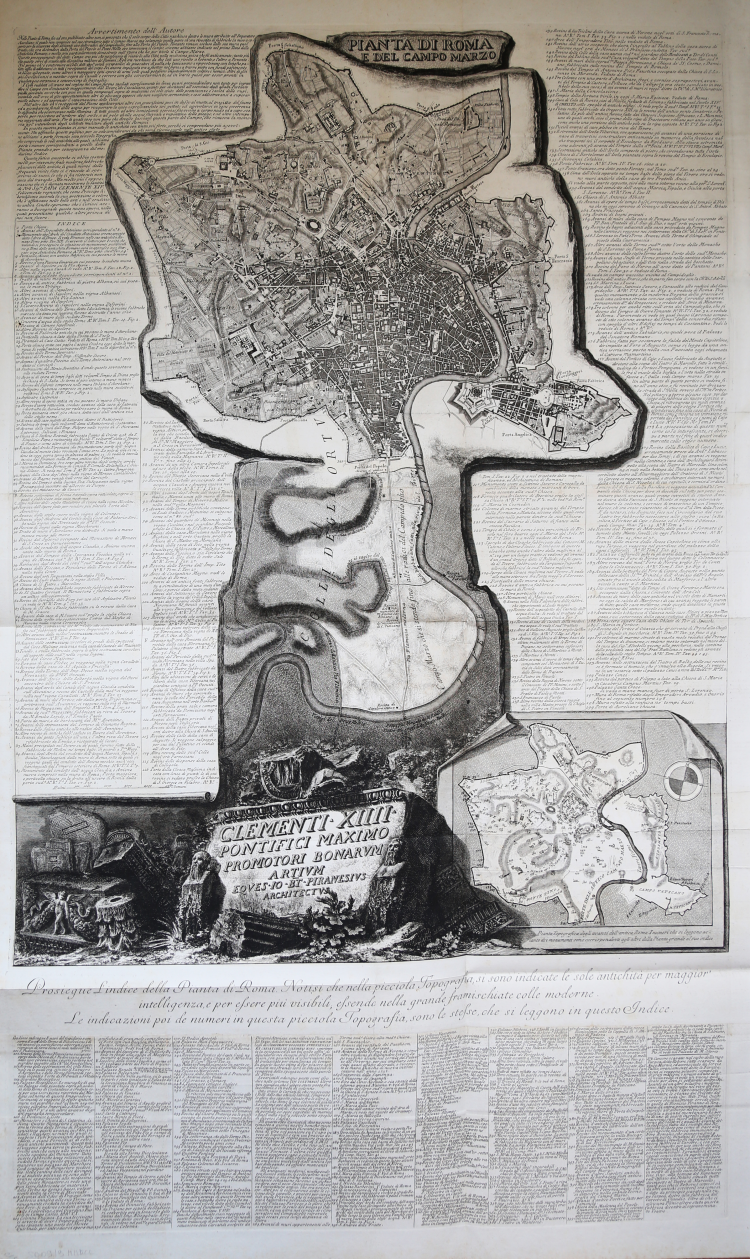



| Reference: | S39811 |
| Author | Giovan Battista PIRANESI |
| Year: | 1774 |
| Zone: | Rome |
| Printed: | Rome |
| Measures: | 1200 x 700 mm |


| Reference: | S39811 |
| Author | Giovan Battista PIRANESI |
| Year: | 1774 |
| Zone: | Rome |
| Printed: | Rome |
| Measures: | 1200 x 700 mm |
Map of Rome and the Campus Martius, formed by three plates and usually found in association with the Vedute di Roma.
He may have felt the need for a reference map to accompany collections of these plates and devised this work to fill this need.
Exercising his skills in presenting formidable quantities of information coherently, he sought to relate the surviving remains of antiquity to the contemporary topography of Rome and to offer an easy reference to published information about them. He therefore produced a large map of the modern city within the Aurelian Walls, together with an extension showing the territory to the north, between Porta del Popolo and Ponte Milvio and including the Campus Martius area.
This is augmented by a smaller map isolating the principal antiquities, which were marked with numbers correspondending to those in the larger map. Around these Piranesi arranged a detailed index listing the monuments according to their assigned numbers and referring to relevant passages in his major pubblications, including the Antichità Romane, Della Magnificenza ed Archittettura dei Romani and Campo Marzio.
The dating of the map is problematic, since, although it is dedicated to Clemente XIV (1769-1774),
Francesco Piranesi's 1792 cataloghe assigns is to 1778 and most authorities, including Giesecke, Focillon and Hind, have accepted a late, if not posthumous date; however this date is certainly based on error, since Giambattista, in his Avvertimento at the top of the main map, refers to "l'approvazione che si è degnata mostrarne la Santità di N.ro Sig.re PAPA CLEMENTE XIV felicemente regnante". Supporting evidence for an earlier date comes from an impression of the Catalogo delle Opere, referred to by Scott, which contains manuscript entries for the three Vedute di Roma datable to 1774 and indicates that the map was already available.
Etching, printed from the plates on three sheets of contemporary laid paper with watermark, double circle with the fleurs-de-lys.
A very good early impression for the contemporary roman edition.
|
Hind, p. 87, [1778-9.]; Focillon 600; Ficacci 700; Wilton-Ely, II, 1008.
|
Giovan Battista PIRANESI (Mogliano Veneto 1720 - Roma 1778)
|
Italian etcher, engraver, designer, architect, archaeologist and theorist. He is considered one of the supreme exponents of topographical engraving, but his lifelong preoccupation with architecture was fundamental to his art. Although few of his architectural designs were executed, he had a seminal influence on European Neo-classicism through personal contacts with architects, patrons and visiting artists in Rome over the course of nearly four decades. His prolific output of etched plates, which combined remarkable flights of imagination with a strongly practical understanding of ancient Roman technology, fostered a new and lasting perception of antiquity. He was also a designer of festival structures and stage sets, interior decoration and furniture, as well as a restorer of antiquities. The interaction of this rare combination of activities led him to highly original concepts of design, which were advocated in a body of influential theoretical writings. The ultimate legacy of his unique vision of Roman civilization was an imaginative interpretation and re-creation of the past, which inspired writers and poets as much as artists and designers.
|
|
Hind, p. 87, [1778-9.]; Focillon 600; Ficacci 700; Wilton-Ely, II, 1008.
|
Giovan Battista PIRANESI (Mogliano Veneto 1720 - Roma 1778)
|
Italian etcher, engraver, designer, architect, archaeologist and theorist. He is considered one of the supreme exponents of topographical engraving, but his lifelong preoccupation with architecture was fundamental to his art. Although few of his architectural designs were executed, he had a seminal influence on European Neo-classicism through personal contacts with architects, patrons and visiting artists in Rome over the course of nearly four decades. His prolific output of etched plates, which combined remarkable flights of imagination with a strongly practical understanding of ancient Roman technology, fostered a new and lasting perception of antiquity. He was also a designer of festival structures and stage sets, interior decoration and furniture, as well as a restorer of antiquities. The interaction of this rare combination of activities led him to highly original concepts of design, which were advocated in a body of influential theoretical writings. The ultimate legacy of his unique vision of Roman civilization was an imaginative interpretation and re-creation of the past, which inspired writers and poets as much as artists and designers.
|